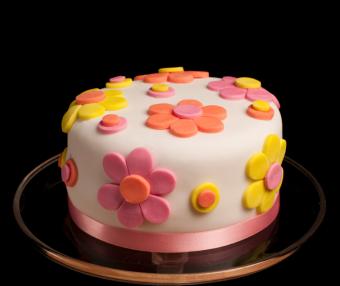
Fondant is a thick and smooth icing known for its clean look. The decorator's first encounter with fondant is often when working on a fondant wedding cake. Fondant gives these usually white cakes a flawless, error-free appearance.
Fondant Basics
The word fondant has the same root word as the French word, fondue, meaning melted. It gets its name because it contains melted sugar. What's interesting is that there is actually a type of fondant known as "poured fondant." It's simply made of sugar and water heated to around 250 degrees F. This type of fondant is too creamy to make for an effective icing and is instead used for decorative touches or as a filling for pastries and some types of candy.
Fondant icing contains sugar, of course, but it also has gelatin or agar mixed into it to help it better take shape. In addition, it contains glycerin, which makes it easy to roll and mold. This icing is also known as "rolled fondant," since you roll it out just like you would a bowl of cookie dough. You don't frost a cake with it in a traditional sense. Instead, you drape the fondant over top of it, kind of like how you would wrap a gift. You can also easily use it to make realistic embellishments in any color of the rainbow. The only thing fondant icing is not good for is creating letters using a piping bag. Instead, you will have to cut letters out of the fondant using a stencil.
Making Fondant
While most any cake shop will sell tubs of ready-made fondant, it is possible to make your own. Since traditional homemade fondant can be difficult to make in the home kitchen, most amateur decorators choose to mix up marshmallow fondant instead. It looks basically the same as the fondant you buy and is very simple. To make it, you'll need a half cup of butter (do not use margarine), an 8 ounce bag of marshmallows, two tablespoons of water, half a teaspoon of vanilla extract and one pound of powdered sugar.

- Soften the butter by letting it sit unrefrigerated for 30 minutes.
- Microwave the marshmallows in a large bowl for 45 seconds, or until they start to melt.
- Add the water and vanilla to the marshmallows, while they are still hot.
- Stirring slowly, gradually add the powdered sugar.
- When the fondant is thick and sticky, rub butter on your hands and remove the dough from the bowl.
- Knead the dough, as you would bread, until it becomes soft and pliable. Add sugar to your hands if the dough starts to stick.
- Once the fondant is not sticky anymore, you can stop kneading.
- Roll the icing into a ball.
- Place plastic wrap tightly around it and place it in the refrigerator.
When it's time to use your fondant, remove it from the refrigerator and let it warm to room temperature. Then simply roll it out using a rolling pin. Again, you can use powdered sugar to prevent sticking. If you'd like to change its color, simply knead in some food coloring or gel. Fondant works best if you let it sit in the refrigerator at least overnight.
A Favorite of Cake Decorating Pros
Professional decorators love working with fondant because of its texture and versatility. You can use it as a beautifully smooth cover over a layer of buttercream, cut shapes and letters out of it for decorating, and mold it into flowers and figures. Once you get comfortable working with fondant, you'll want to use it all the time.







